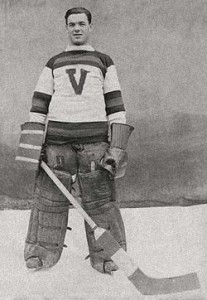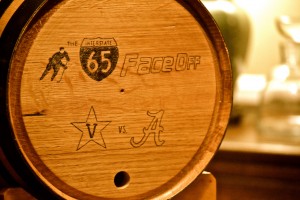With a new opponent (Alabama) set to face the Commodores in the 2013 Face Off, the need arose to find a new trophy worthy of the event, programs, and of course the “Cullie” – the trophy at stake between Vanderbilt and Tennessee. (Read more about the history and origins of the Cullie here.) A trophy committee was subsequently assembled to find an artifact representative of the unique nature of the I-65 rivalry.
Looking For The Connection
Following a weeks-long inventory of the University archives in both Nashville and Tuscaloosa to uncover a meaningful hockey-related connection between the two schools, the committee reported back that they had, to quote chairwoman Elizabeth Brooks, “struck platinum-covered gold” in their research.
According to records, a blizzard in the early months of 1908 swept across the Southeast leaving many cities, including Nashville and Tuscaloosa, buried in more than three feet of snow. The result was a weeks-long state of paralysis throughout the region. School was cancelled, roads were closed, and virtually all residents were confined to their homes. Everyone, that is, except a brave few who turned a fairly daunting predicament into their own winter wonderland of commerce and recreation.
 In Nashville, a group of Vanderbilt students led by Michigan-native Oliver Jay worked to tamp down the walking trails throughout campus and surrounding city neighborhoods in order to create skating paths people could use to transport themselves and key essentials. The endeavor was part altruism and part business for Jay who, as an avid skater, made a minor fortune shuttling food and medicine throughout the city for local merchants and doctors.
In Nashville, a group of Vanderbilt students led by Michigan-native Oliver Jay worked to tamp down the walking trails throughout campus and surrounding city neighborhoods in order to create skating paths people could use to transport themselves and key essentials. The endeavor was part altruism and part business for Jay who, as an avid skater, made a minor fortune shuttling food and medicine throughout the city for local merchants and doctors.
In his recounting of the experience in the 1907/08 Vanderbilt yearbook, Jay recalled his particular fondness for “skating the quad.” He explained that “[those paths] were the most incredible things. Whereas a normal walk from one part of campus to another might take twenty minutes, skating the distance would cut that trek down to a fraction of the time.”
Jay and his classmates also took the opportunity to introduce the campus and city to the great game of ice hockey. Directly in the center of Centennial Park, Jay set about building a skating surface just as he had every winter growing up outside of Detroit. The only problem for the group? Not enough skates and virtually no equipment.
“By some cosmic chance, I happened to tow my goalie equipment with me when I left for school in August,” wrote Jay. “My thought was that we’d play floor hockey and my equipment would give the boys playing a good charge. Of course, here we are in Nashville, Tennessee, with three feet of snow and I’m actually using the gear for its intended purpose. Amazing odds to say the least.” The other players cobbled together football pads and old newspapers that proved to be sufficient for a series of pick-up games that were “a fun diversion for all of us.”
Meanwhile, 250 Miles To The South …
While Nashville was doing its best to dig out of Snowmageddon, in Tuscaloosa another group of midwesterners set about laboring through the storm in much the same way, only with greater fan fare and organization. Led by senior Sterling Holyoke, a Minnesota native and star baseball prospect, a group of students decided it would be a great idea to turn the baseball stadium into an early version of the NHL’s modern day Winter Classic. Holyoke and his classmates took the lead in orchestrating an event that pitted the Harris and Riverside dormitories against one another in a game that drew nearly 1,200 fans.
 Harris residents Edward Martindale and Stanton Weissenmack were in charge of building the nets and securing equipment, respectively, while Riverside resident and player Davis Nobel requisitioned uniforms from the University’s rugby team. The only problem? Availability of skates, a challenge that was thankfully overcome when a local cobbler named Denton Ware offered to retrofit knives onto the bottom of old boots.
Harris residents Edward Martindale and Stanton Weissenmack were in charge of building the nets and securing equipment, respectively, while Riverside resident and player Davis Nobel requisitioned uniforms from the University’s rugby team. The only problem? Availability of skates, a challenge that was thankfully overcome when a local cobbler named Denton Ware offered to retrofit knives onto the bottom of old boots.
All totaled, it was a patchwork affair that served to brighten the spirits of the students and community members in attendance. Said Holyoke in his only recorded comment about the experience, “It was like transporting the heart of St. Paul to my other favorite home [at Alabama]. I’ll cherish the memory forever.”
Out Of A Storm, A Trophy Is Born
With the anecdotal nexus and associated folk lore in hand, the trophy committee turned to determining what the trophy itself might be. After much deliberating, the team landed on the idea of turning a whiskey barrel into the prize, both for its gravitas as an artifact as well as its significance to the storm of 1908.
 Explained Brooks, “You have to consider the seriousness of the event and the lack of preparedness of the people in both communities. How would they, among other things, avoid freezing to death? For many, the answer was to ration a nip of whiskey here and there, just enough to warm the body amidst the brutally cold weather.”
Explained Brooks, “You have to consider the seriousness of the event and the lack of preparedness of the people in both communities. How would they, among other things, avoid freezing to death? For many, the answer was to ration a nip of whiskey here and there, just enough to warm the body amidst the brutally cold weather.”
And so it stands that more than a century later the Vanderbilt and Alabama ice hockey teams will honor those who weathered the storm in both Nashville and Tuscaloosa by playing for the Jay Holyoke Memorial Trophy, otherwise known to the committee as “The Holy.”
“Every great trophy needs a nickname,” said Brooks. “I think the boys will be excited about our work and have a lot of fun battling for the Holy for years to come.”
* Mark your calendars folks, the big game is just about a week away on Friday, April 12th, at Bridgestone Arena. The boys will play following the Nashville Predators tilt versus the Dallas Stars so count on a great double-header at the Arena. (Note that to watch the I-65 you’ll have to have a ticket to the first game as well. For discounted seats visit: http://www.nashvillepredators.com/I65Faceoff.) On behalf of both teams, we appreciate your support leading up to the game and look forward to putting on a great show!

